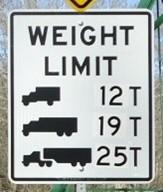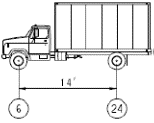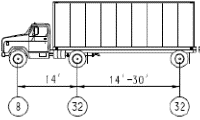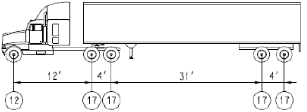Bridge Load Posting and Overload Permits
Baltimore County may at times post a bridge for weight restrictions less than Maryland legal vehicle weights. The maximum gross vehicle weight (GVW) for Single Unit Vehicles and maximum gross combined weight (GCW) for Combination Vehicles in Maryland are below.
| Axles | Type | Maximum GVW |
|---|---|---|
| 2 axle | H-15 | 15 tons = 30,000 pounds |
| 3 axle | Type 3 (dump truck—obsolete) | 33 tons = 66,000 pounds |
| 4 axle | Type 4 (dump truck) | 35 tons = 70,000 pounds |
| Axles | Type | Maximum GVW |
|---|---|---|
| 3 axle | HS-20 (semi-trailer) | 36 tons = 72,000 pounds |
| 5 axle | Type 3S2 (18 wheels) | 40 tons = 80,000 pounds |
EXAMPLES
For a bridge to be posted, at least one of the vehicles described above will be displayed on a highway sign at less than its maximum GVW or GCW. The weight limit will be posted either in tons (Example 1) or pounds (Example 2), depending on the type of sign used at the bridge. The silhouette-type sign (Example 1) generally displays the reduced weight limit for the obsolete Type 3 dump truck. Baltimore County is in the process of converting load posting signs from tons to pounds, however, both types of signs are in use on County roadways.
Example 1

This sign indicates the following vehicles and their weight limit:
- H-15—12 ton weight limit
- Type 3—19 ton weight limit
- Type 3S2—25 ton weight limit
Example 2

This sign indicates the following vehicles and their weight limit:
- H-15—No restriction
- Type 3 and Type 4—57,000 pounds
- HS-20 and Type 3S2—69,000 pounds
OVERLOAD PERMITS
An overload permit is required to:
- Cross a load posted bridge or culvert structure with a vehicle that exceeds the posted weight restrictions
- Cross any County bridge or culvert structure in the inventory with a vehicle that weighs more than Maryland legal vehicles (i.e., an “overweight vehicle”), regardless of whether or not the structure is posted for load restrictions. A need for a permit in other states and jurisdictions will probably indicate a similar need in Baltimore County. Vehicles such as heavy cranes and lowboys with many axles generally fall into this category.
REQUEST AN OVERLOAD PERMIT OR RENEWAL
Failure to obtain proper permits prior to crossing Baltimore County structures will result in tickets, fines or court action. View an example of an overload permit.
The overload permit request letter must contain:
- A sketch or diagram of the vehicles showing:
- Axle spacing in feet or inches
- The maximum axle weights in pounds
- An accurate description of the proposed truck route or location of the structures to be crossed.
If the permittee has been issued a Special Hauling Permit by the Maryland Department of Transportation, much of the above required information is included in that permit and submitting it with the request will expedite the permitting process.
Requests to renew permits must contain all of the above information with each request, even if there are no changes to axle spacing or weight. As bridges age, a reduction in GVW or GCW may be required.
Failure to submit the permit request as described above may delay the permitting process.
There is no fee to request an overload permit. Submit your request in writing to:
Lisa K. Eicholtz, P.E., Chief
Bureau of Engineering and Construction
111 West Chesapeake Avenue, Room 219
Towson, Maryland 21204
If granted, the permit will be issued and must be carried in the vehicle when crossing the structures.
Generally, permits will be valid for a single move, however, permits requested for frequent crossings may be valid for up to one year, depending on an evaluation of the condition of the structures and the frequency of crossings.
PERMIT DENIAL
It is noted that some structures are already near their maximum capacity under normal traffic and cannot tolerate any additional weight, in which case a permit request may be denied.
STANDARD POSTED VEHICLES
Below are diagrams for standard posted vehicles. Please note that all numbers in circles are axle loads in 1,000 pounds (i.e. 6 = 6,000 pound axle load).
Single Unit Vehicles
| H-15(30,000 pounds) | Type 3(66,000 pounds) | Type 4(70,000 pounds) |
|---|---|---|

|

|

|
Combination Vehicles
| HS-20 (72,000 pounds) |
3S (80,000 pounds) |
|---|---|

|

|